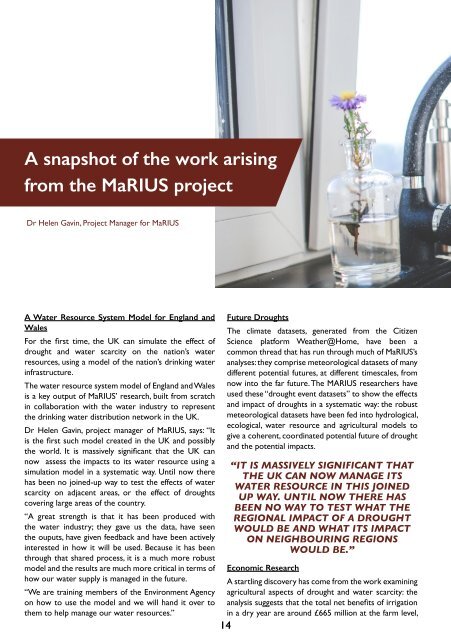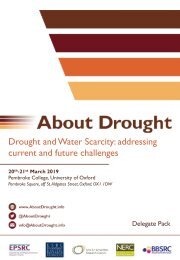About Drought Handbook: Outputs & Impacts
As the UK’s £12m Drought and Water Scarcity (DWS) research programme reaches its conclusion with a final event at The Royal Society in London, this handbook draws together the key outputs and outcomes. The book also features a series of interviews with our leading stakeholders, which highlight how successfully we have met our objectives to produce cutting-edge science that has made a demonstrable impact on how decision-makers manage water scarcity in the UK.
As the UK’s £12m Drought and Water Scarcity (DWS) research programme reaches its conclusion with a final event at The Royal Society in London, this handbook draws together the key outputs and outcomes. The book also features a series of interviews with our leading stakeholders, which highlight how successfully we have met our objectives to produce cutting-edge science that has made a demonstrable impact on how decision-makers manage water scarcity in the UK.
- No tags were found...
Create successful ePaper yourself
Turn your PDF publications into a flip-book with our unique Google optimized e-Paper software.
A snapshot of the work arising<br />
from the MaRIUS project<br />
Dr Helen Gavin, Project Manager for MaRIUS<br />
A Water Resource System Model for England and<br />
Wales<br />
For the first time, the UK can simulate the effect of<br />
drought and water scarcity on the nation’s water<br />
resources, using a model of the nation’s drinking water<br />
infrastructure.<br />
The water resource system model of England and Wales<br />
is a key output of MaRIUS’ research, built from scratch<br />
in collaboration with the water industry to represent<br />
the drinking water distribution network in the UK.<br />
Dr Helen Gavin, project manager of MaRIUS, says: “It<br />
is the first such model created in the UK and possibly<br />
the world. It is massively significant that the UK can<br />
now assess the impacts to its water resource using a<br />
simulation model in a systematic way. Until now there<br />
has been no joined-up way to test the effects of water<br />
scarcity on adjacent areas, or the effect of droughts<br />
covering large areas of the country.<br />
“A great strength is that it has been produced with<br />
the water industry; they gave us the data, have seen<br />
the ouputs, have given feedback and have been actively<br />
interested in how it will be used. Because it has been<br />
through that shared process, it is a much more robust<br />
model and the results are much more critical in terms of<br />
how our water supply is managed in the future.<br />
“We are training members of the Environment Agency<br />
on how to use the model and we will hand it over to<br />
them to help manage our water resources.”<br />
14<br />
Future <strong>Drought</strong>s<br />
The climate datasets, generated from the Citizen<br />
Science platform Weather@Home, have been a<br />
common thread that has run through much of MaRIUS’s<br />
analyses: they comprise meteorological datasets of many<br />
different potential futures, at different timescales, from<br />
now into the far future. The MARIUS researchers have<br />
used these “drought event datasets” to show the effects<br />
and impact of droughts in a systematic way: the robust<br />
meteorological datasets have been fed into hydrological,<br />
ecological, water resource and agricultural models to<br />
give a coherent, coordinated potential future of drought<br />
and the potential impacts.<br />
“IT IS MASSIVELY SIGNIFICANT THAT<br />
THE UK CAN NOW MANAGE ITS<br />
WATER RESOURCE IN THIS JOINED<br />
UP WAY. UNTIL NOW THERE HAS<br />
BEEN NO WAY TO TEST WHAT THE<br />
REGIONAL IMPACT OF A DROUGHT<br />
WOULD BE AND WHAT ITS IMPACT<br />
ON NEIGHBOURING REGIONS<br />
WOULD BE.”<br />
Economic Research<br />
A startling discovery has come from the work examining<br />
agricultural aspects of drought and water scarcity: the<br />
analysis suggests that the total net benefits of irrigation<br />
in a dry year are around £665 million at the farm level,




